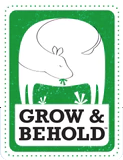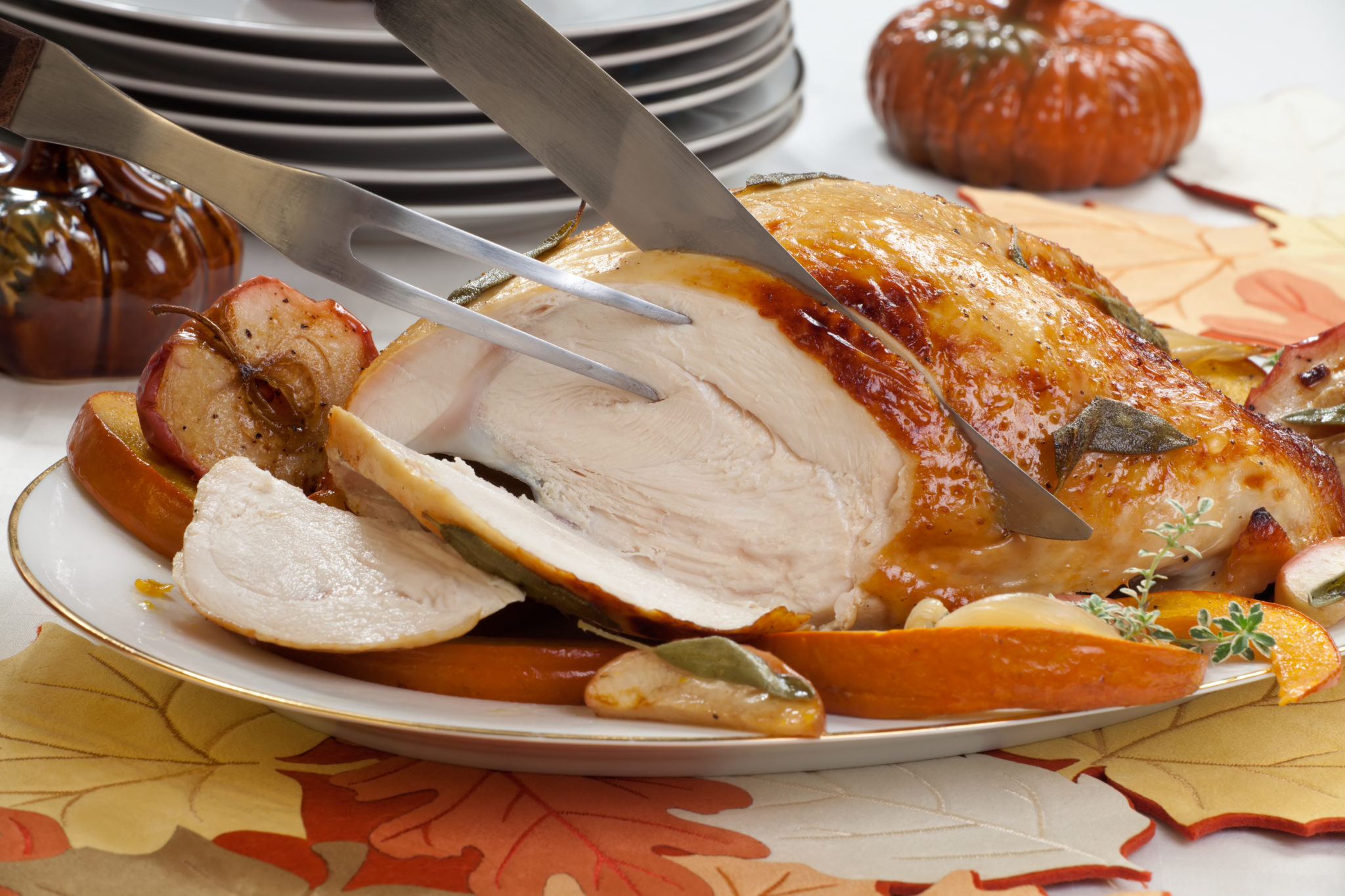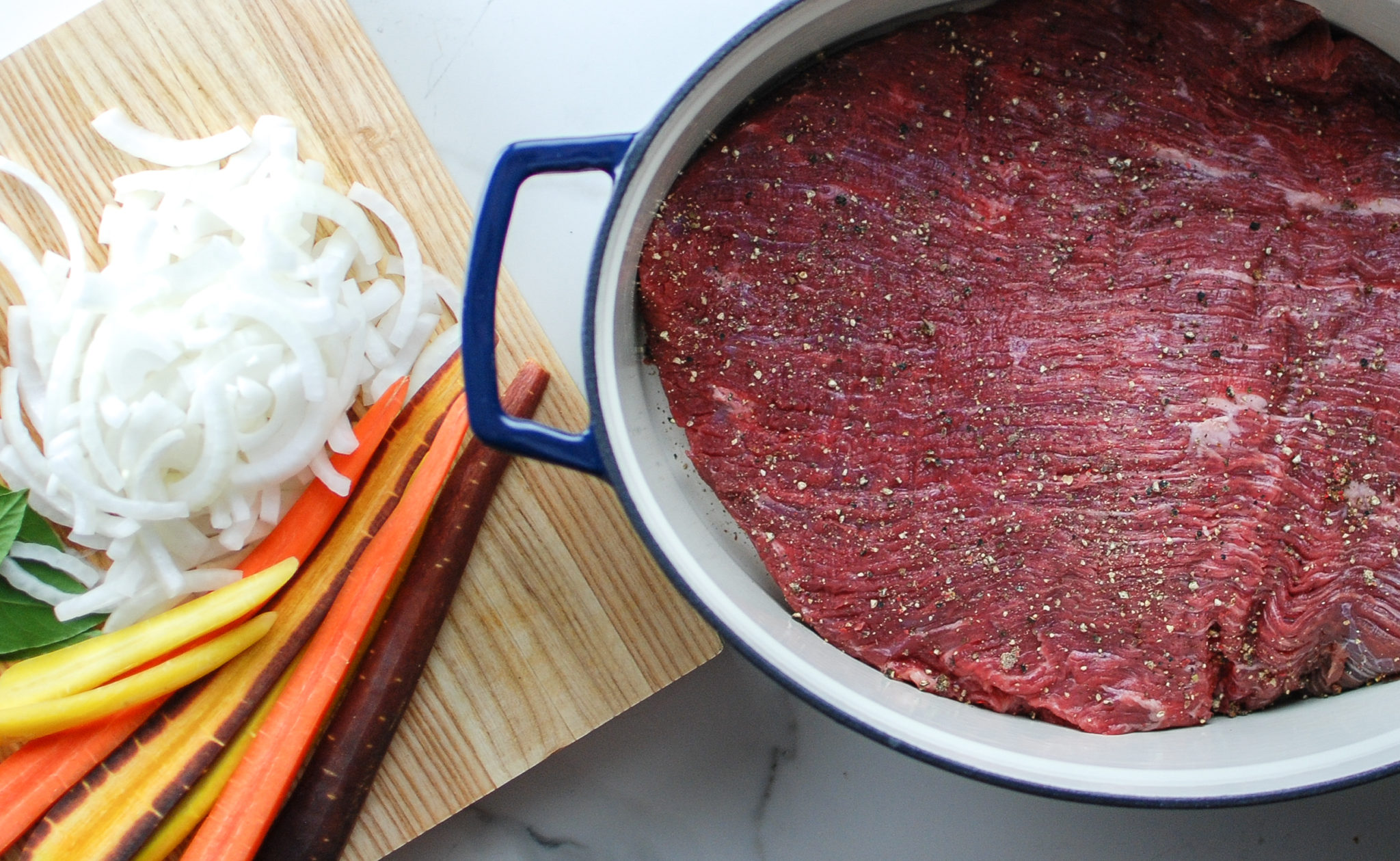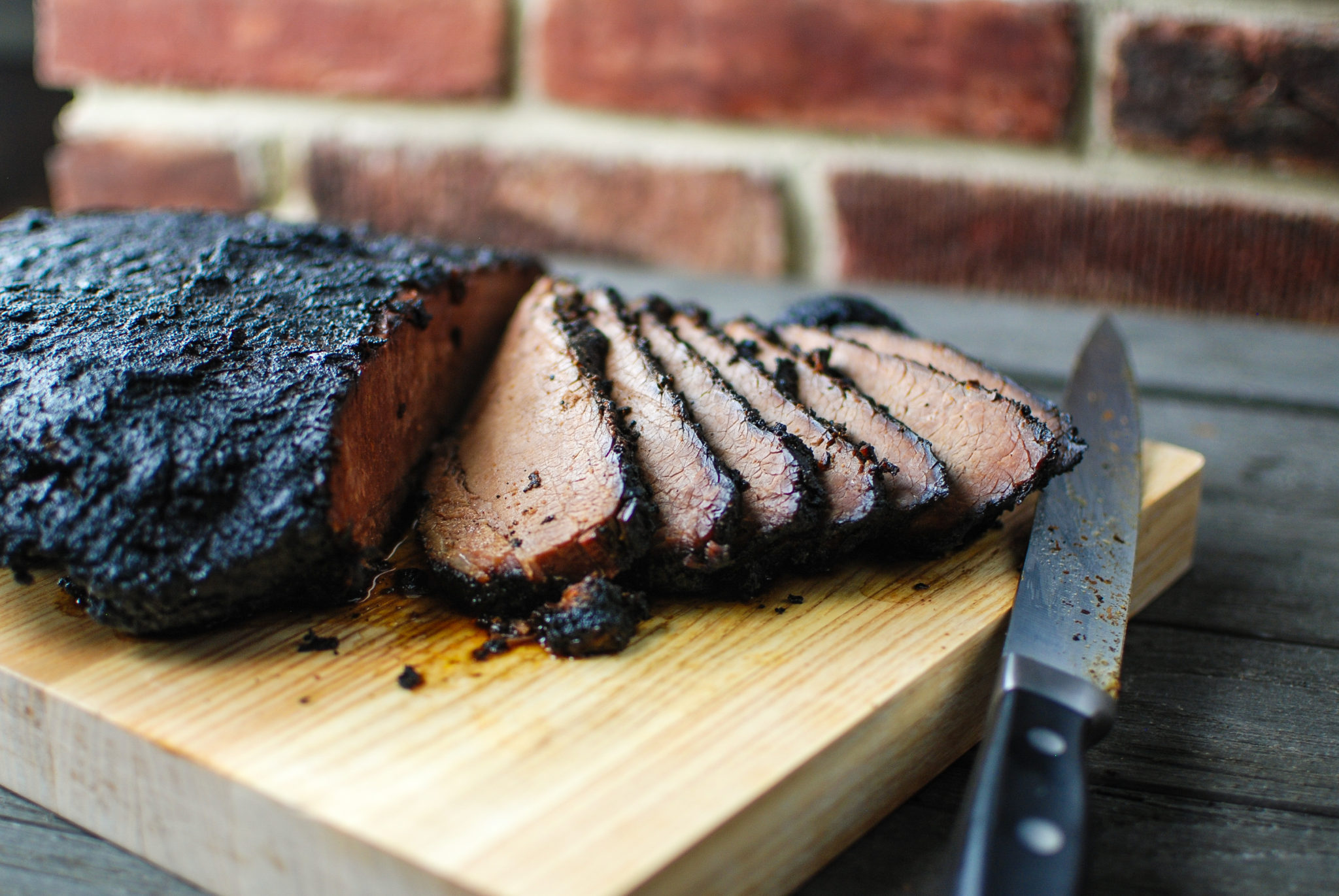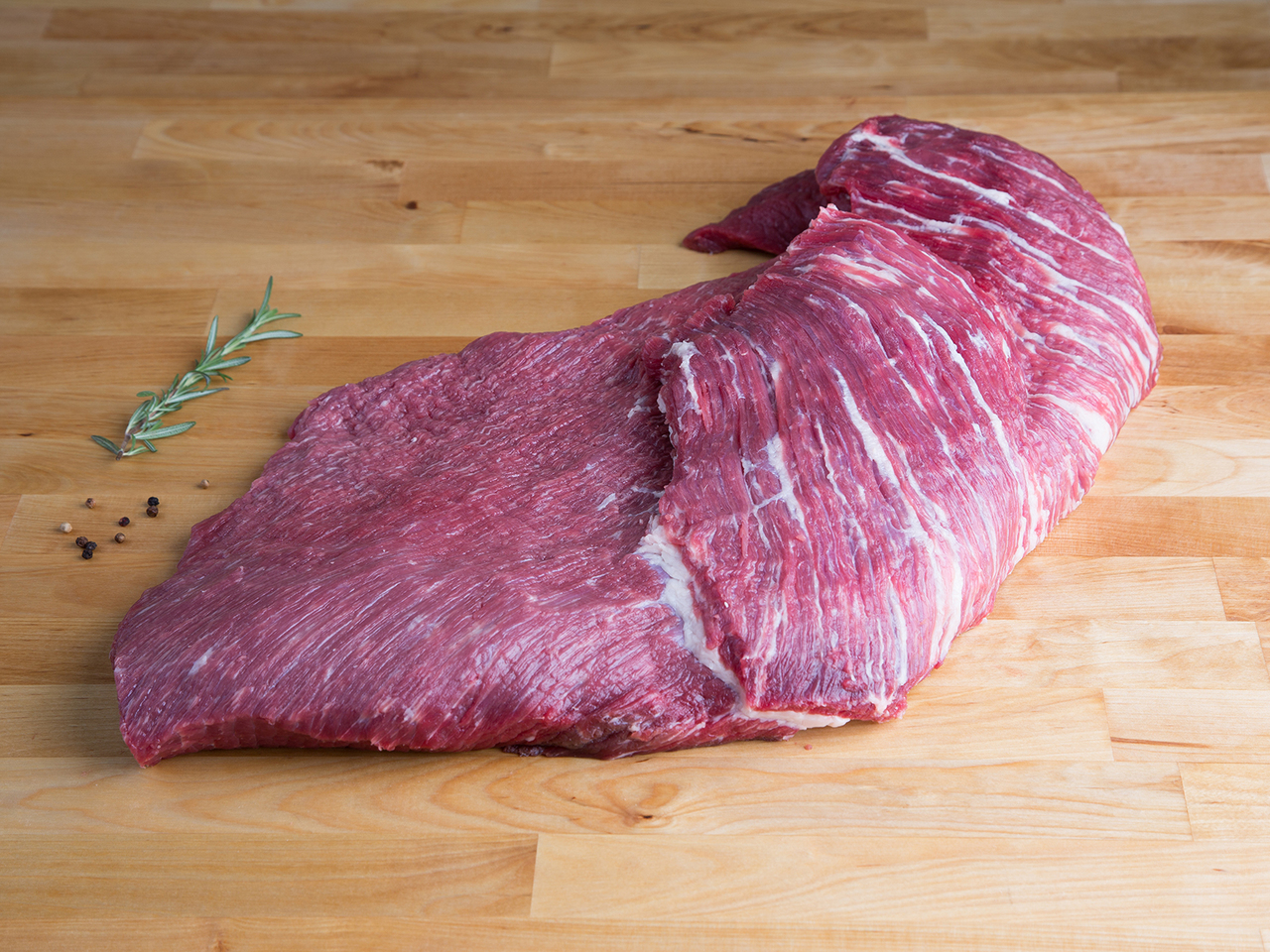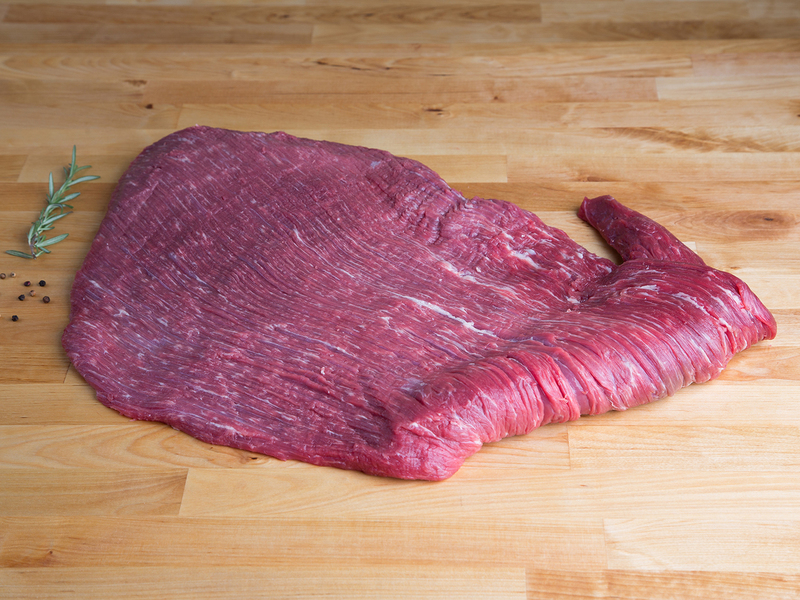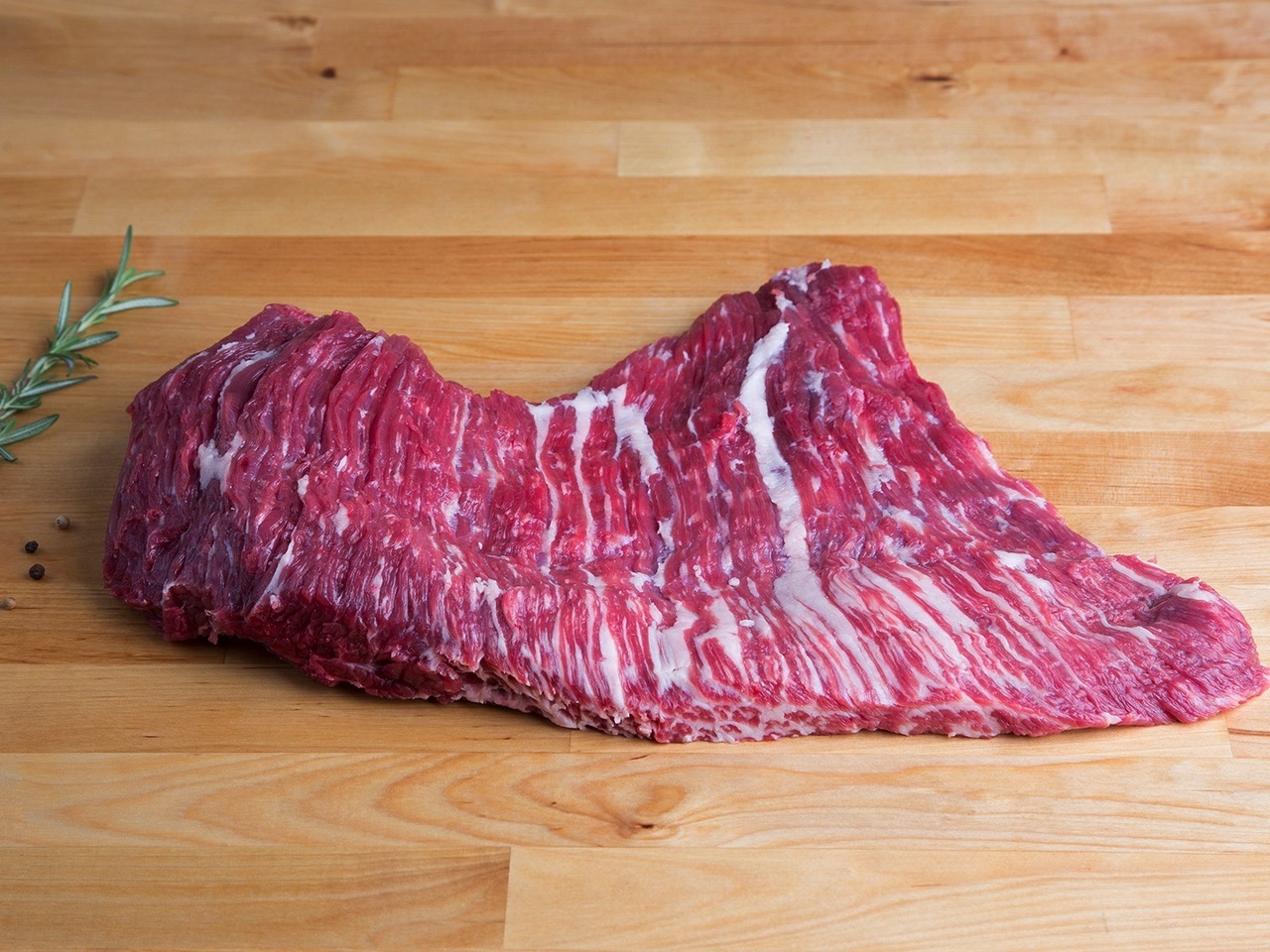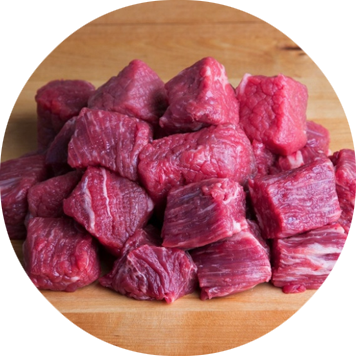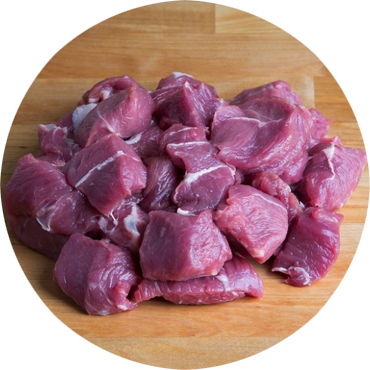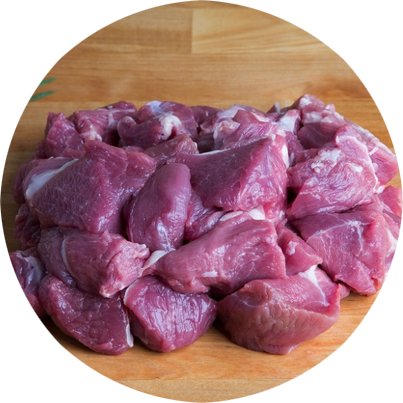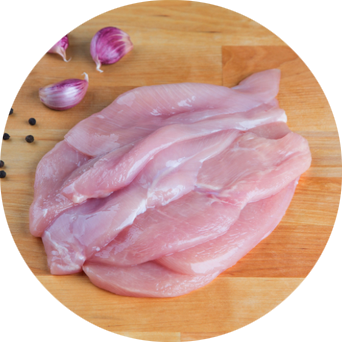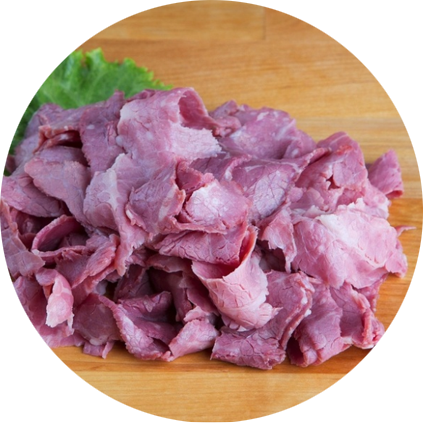There is no way around it, brisket is an intimidating cut to cook, but when done right with tried and true techniques, it’s well worth it. If it’s your first time cooking with brisket or just want to up your brisket game, this guide will help you become a brisket pro and produce a fantastic meal for your family. You’ve got a few factors to consider before you set out to cook an amazing brisket: what cooking style, what spices, which cut of brisket. We’ll cover all of this and more in this guide, and if you need more support you can reach us at 888-790-5781 or info@growandbehold.com.
But before we get into the delicious details, let’s spend some time understanding just what brisket is and how to ensure you’re working with the highest quality, premium kosher meat to ensure an amazing meal.
Choosing the Perfect Cut of Beef Brisket
The beef brisket consists of the “breast” of the steer. It’s the pectoral muscles of the steer, which get a serious workout during the animal’s life.

It’s important to consider the quality of your selected cut because brisket is a relatively tough muscle. But choosing a high-quality, Kosher brisket can help with your cook time and quality right off the bat.
“Regular” Beef vs Premium Kosher Beef
Brisket has historically been one of the cheapest parts of the steer to buy, and pretty much any grocery store will carry it, but that doesn’t guarantee a great meal. As it is with most things, you get what you pay for.
Kosher certification guarantees a cleaner, safer, and higher quality cut of meat as compared to non-Kosher meat found in your local grocery. In fact, 62 percent of customers choose kosher foods because of health and quality, not necessarily a cultural or religious necessity.
But just because something is labeled kosher doesn’t necessarily mean it is of the highest quality. Kosher laws do not ensure that animals are raised with the space they need, and mainstream kosher meat is often produced with antibiotics and hormones to speed growth — just like non-kosher conventional meat!
At Grow & Behold, we take many additional steps beyond the Kosher certification requirements. Our premium kosher beef is sourced from hand-picked U.S. Black Angus, raised on pasture, humanely handled, grass fed, grain finished, and never treated with growth hormones or antibiotics.
If your aim is to produce the very best brisket for your family that tastes amazing and is thoughtfully produced, a brisket from Grow & Behold a great place to start.
First Cut Brisket vs Second Cut Brisket vs the Whole Brisket
First things first. What are all the different kinds of brisket?
First Cut Beef Brisket

The most common cut is called “first cut” or “flat cut” brisket.
This is the larger of the two muscles that make up the whole brisket, and it’s much leaner than the second cut, and therefore can be tougher, depending on how it is cooked. Located below the second cut on the steer, the first cut can be anywhere from 3.5 to 10lbs.
While there are many factors that influence the beef flavor and tenderness, fat content is a significant factor. Since the first cut is so lean, it takes longer to cook, and some people like to use sweeter, or more complex flavors when working with first cut brisket. First cut brisket is particularly well suited for pot roast recipes and corned beef.
Second Cut Beef Brisket

“Second cut” — or “point cut” — is the part of the brisket that sits on top of the first cut, separated from it by a generous pocket of fat.
The second cut has much more intramuscular fat, or marbling, that makes it extremely tender and flavorful when cooked. These cuts are smaller — about 1.5 to 3 pounds.
The second cut is also extremely forgiving while cooking, due to its higher fat content. If it’s of premium quality, it can be seasoned with nothing but salt and pepper (although you can certainly use a more complex spice rub and glaze). Second cut is great for smoking, low roasting, or slow cooking into the best pulled beef you have ever tasted. Because of its marbling and looser grain, second cut is harder to slice, especially if it’s cooked for a long time.
Whole Beef Brisket

A “whole brisket” is a great option when you are cooking for crowds.
The second cut is great for those who enjoy a fattier meat, while the first cut will be good for those who want a leaner slice. The fat that separates the two muscles will also baste the first cut and help keep it moister that it might be cooking on its own. When braising a whole brisket, keep the first cut underneath, since it’s more important that the first cut is submerged in the cooking liquid. A whole brisket can weight from 6.5-12lbs.
For smoking, dry roasting, or curing, you may want to consider a whole brisket with some of the fat left on top. The most typical fabrication styles are the “deli-cut” brisket, in which the surface fat is trimmed to about a quarter inch, or the “packer-cut”, where the fat is left “au natural” and can be as thick as 2-3 inches on the surface. The main reason to use a packer or deli-cut brisket is to keep the meat protected and moist during a long, slow smoking.
Many barbecue experts insist that only the ¼” fat cap is necessary, and eschew the packer since there is a notion that rubs and marinades only penetrate about ¼” into the surface of the meat. Others prefer the protection and flavor that a thick and rich fat cap provides, and others like to buy a packer cut, so they can enjoy trimming it down themselves. Deli cut briskets will typically weigh 12-20lbs, and packers can run 14-25 lbs, depending on the steer.
Braising & Smoking: Two Great Options for Cooking Brisket
We’ve seen everything from pesto brisket to pineapple brisket, but the two most popular methods are the Ashkenazi Jewish “braised brisket”, and the Texas BBQ-style smoked brisket.
We’ll explain the differences between these two styles, give you the basic technique, and share some more recipes for you to try as you branch out and develop your own brisket-cooking style.
Ashkenazi Jewish-style Braised Beef Brisket
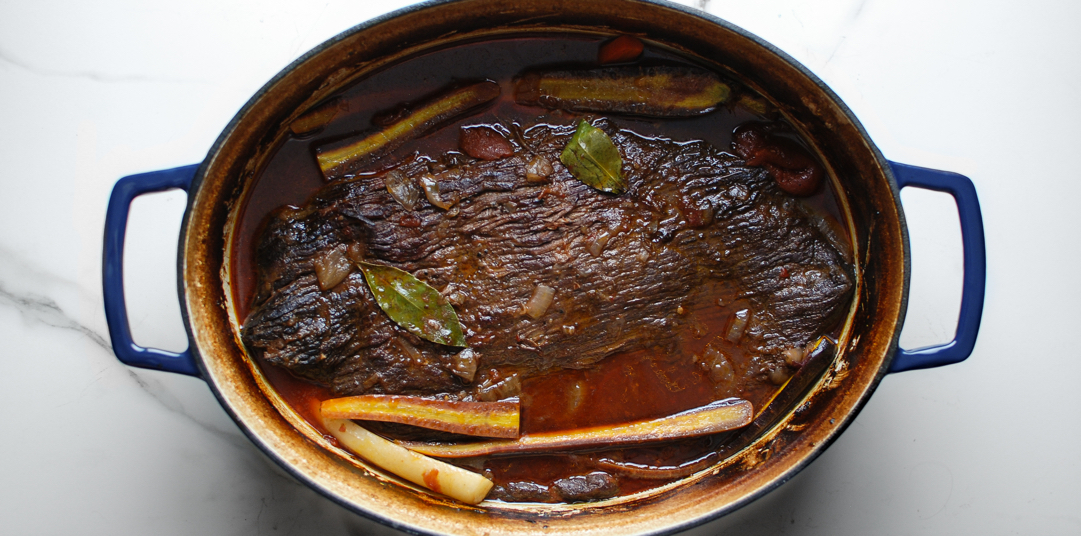
For many, braised beef brisket (also commonly referred to as “pot roast”) is the definition of comfort food. It’s a common technique in Ashkenazi Jewish cooking, but no matter who you are you have to try it.
After seasoning and searing the meat, the brisket is placed in a pot to cook slowly over many hours. This kind of cooking is be done indoors, using a traditional Dutch Oven pot with your home oven or a slow-cooker. Garlic, onions, herbs, and tomatoes are the most typical flavors in traditional braised brisket.
“Texas-style” Smoked Beef Brisket
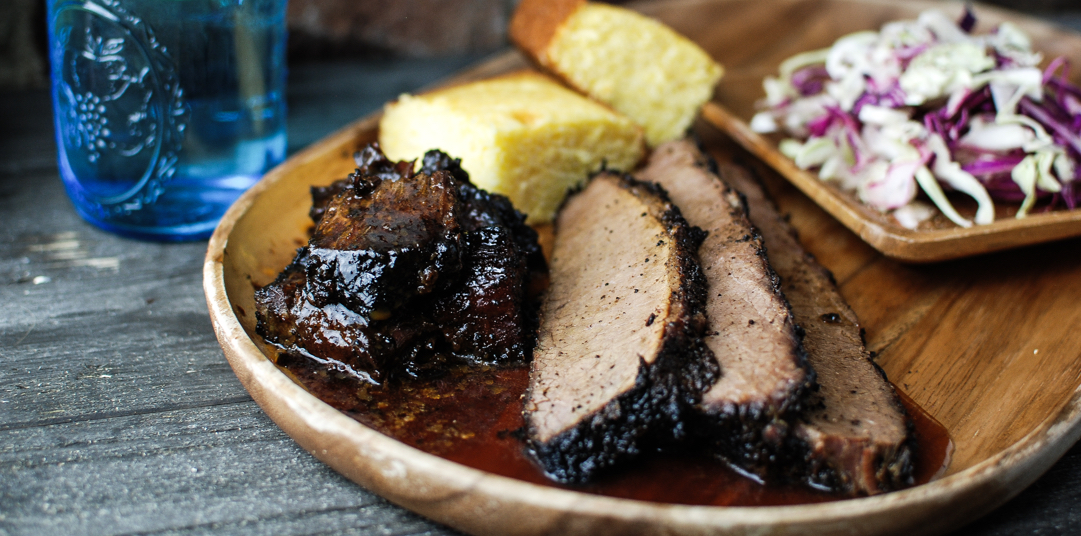
Texas-style smoked BBQ brisket was named one of the “hottest food trends” of 2017 and the kosher world, already familiar with brisket from the Shabbat and holiday table, lost no speed in joining in.
A recent collaboration between Izzy’s Brooklyn Smokehouse (in Brooklyn, New York) and Franklin’s BBQ (in Austin, Texas) is a great example of this. In the New York area today there are now at least 4 kosher smokehouses! But you don’t need to be from Texas or have fancy facial hair to smoke amazing brisket — if you start with the right brisket, you can get those results, too.
The basic strategy is this: Rub your brisket with seasonings, and cook slowly on a smoker over charcoal or wood. The rest, as they say, is in the details (which we’ll give you in a sec).
Because smoking brisket takes many hours, and grilling over charcoal or wood is generally done outside, smoking a whole brisket is often associated with a special event or a party. Since most smokers can hold at least 20 pounds of meat and take some time to heat up, grabbing a whole brisket is a good idea.
How to Cook Brisket
Now that you know how to pick the right cut of meat and the cooking style for the occasion, we’ll dive into exactly how to end up with an amazing meal. But first, here are a few of the basic rules for any kind of brisket cooking.
General Beef Brisket Cooking Tips
- Kosher beef needs less salt. Because Kosher salt is used as part of the process of making meat kosher, you may want to use less salt than you’d think when seasoning. Think, too, about how your selected spices and aromatic herbs will play with the salt as you may want to adjust for taste.
- Cook slow and low. You can’t rush perfection. If you want the meat to fall apart easily, prepare to cook it for upwards of 1.5 hours per pound at a low, steady heat. But the good news is that it’s basically a hands-off process, so you can leave it to cook while you go about your day. If you want to slice your brisket, your cook time can be closer to 1hr per pound. plan for about an hour per pound, but keep in mind that it’s easier to slice cold, so allow an hour after it comes off the smoker for it to cool before you slice.
- Cool, slice and serve the next day! Braised brisket is always easier to slice when chilled and it actually tastes better when reheated the next day, as the flavors have a chance to meld. Cool your brisket after cooking, skim fat as desired, then slice cold. Arrange in a pan covered in sauce and reheat slowly before serving.
- Cut against the grain. Otherwise, it will be tougher to eat. Cutting against the grain of the meat will break up the muscle fibers, which means less chew and more of that melt-in-your-mouth effect good brisket is known for.
- Assume a half pound per person. That’s the best estimate to determine just how much meat to buy (or how many people to invite to dinner) — unless there are hungry teenagers involved, and then all bets are off!
- Try a brisket-esque cut to save a few bucks. Braised brisket is more versatile than smoked brisket, and can be done with any size brisket, so it’s perfect for a family meal or a large holiday gathering. It’s a staple of Jewish holidays, following a long-honored tradition that sprung from the time when briskets were one of the cheaper cuts of meat, due to their relatively large size and toughness when compared to the cuts that are typically used for other roasts and steaks. Today, in part due to the popularity of brisket in the Jewish diet and the increased demand for briskets created by the BBQ craze, brisket is, in fact, one of the more expensive cuts!
- Top of the Rib: this cut is like a cross between first and second cut brisket, with a slightly beefier flavor. It slices beautifully (doesn’t shred like a second cut) but has more fat than the first cut, making it harder to dry out. Typically available at 2.5-4lbs
- Deckel: this leaner cut from the shoulder is similar to a first cut brisket, and takes incredibly well to braising. A great lower cost alternative to first cut brisket that could fool most eaters!
- Brisket Strip: This small cut is really a perfect “mini-brisket for two”. With the same muscle structure and marbling as a first cut brisket, it’s a great way to get the comfort food you are craving, without having to cook an entire 4+lb first cut brisket.
How to Smoke Beef Brisket
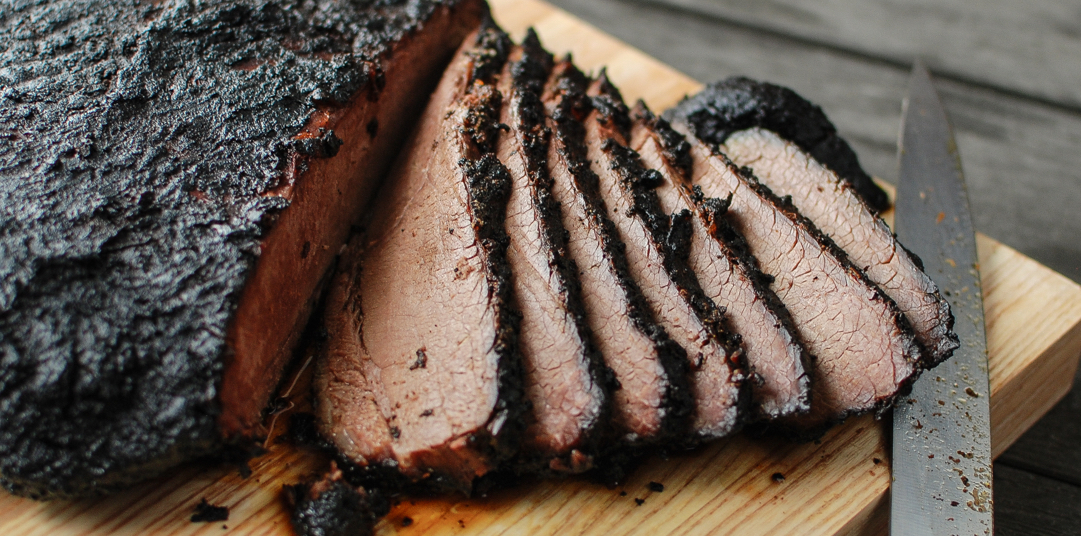
The perfect smoked beef brisket should be tender with a sharp, crisp outer bark of flavor.
To achieve this, first gather your ingredients and tools. This includes your whole brisket (which can be 12 to 24 pounds of meat), your selected rub (could be as simple as salt and pepper), choice of wrap (we’ll get to that in a sec), and your smoker or grill.
When you’re ready, here are the basic steps to smoke beef brisket:
- Preheat your smoker to a temperature between 225 and 250 degrees F.
- Trim any excessive amount of fat down to about a quarter inch thick. You do want some fat, but like anything else, in life you can have too much of a good thing. Pro tip: Cold meat is easier to cut.
- Apply your rub. If this is your first brisket, you may want to just stick to coarse salt and pepper so that you’re focused on the taste of the meat rather than the marinade. A couple tablespoons of brown sugar is a great addition to get some extra caramelization.
- Insert your meat thermometer probe into the thickest part of the first cut. Place the brisket in your smoker with the fat covered part on top.
- Let it cook! Check it as little as possible to maintain your smoker temperature, but do keep an eye on the temperature for the same reasons. Depending on your smoker, add wood chunks as needed to keep up a steady flow of smoke.More about the wood: The wood you use, either as the primary fuel source or as added chunks to produce smoke, can have a tremendous impact on flavor. Each type of hardwood has its own unique flavor, but the most popular are hickory, mesquite, and apple. Our founder Naf smokes his meat exclusively with applewood for the sweet and clean flavor of the smoke!
- OPTIONAL: wrap it in a large sheet of foil or butcher paper when the internal temperature reaches 165 degrees F. This can speed the cook time and help retain moisture. But it’s perfectly fine to keep it unwrapped if you have the time.If you don’t wrap your brisket, you’ll like see a “stall” in temperature when you hit the 165-degree mark. Don’t be alarmed — it’s doing what it’s supposed to! The water in the outer ½” of meat is evaporating, which also cools the meat and keep the temperature from rising. This makes a great bark, but slows the cooking. Your brisket will break out of the stall in 1-6 hours and get back to climbing as long as you keep your temperature steady. Wrapping your brisket with foil or paper stops the evaporative cooling and helps the meat move through the “stall” more quickly, but it can negatively impact the development of your “bark”. Naf doesn’t wrap his briskets unless he’s in a rush —but who’s really rushing a smoked brisket?
- Wait for the jiggle! Yep, you can actually *see* when it’s done — use a sharp knife to probe your brisket, or just give it a jiggle. The perfect balance of tenderness and moisture is produced when the collagen in the meat breaks down and converts to gelatin. This occurs when the internal temperature of the meat reaches 185F to 195F. How much you cook it after this point is a matter of taste. Cooked to ~195F, your brisket can be sliced; cooked to ~200F, it will pull apart.
- …but don’t slice it yet! Let it rest for at least one hour before slicing it.
- When you’re ready to serve, cut against the grain with a very sharp knife. Cut smaller slices on the lean side and larger slices on the fattier side. Only cut when you’re ready to serve so it doesn’t dry out.That’s it! All in all, it may take up to 18 hours (!) from beginning to end, so it’s definitely a day-long project. Make sure you have tons of friends and family around to enjoy.
Here are some recipes for spice rubs you can try on your next smoked brisket using this technique!
How to Braise Beef Brisket
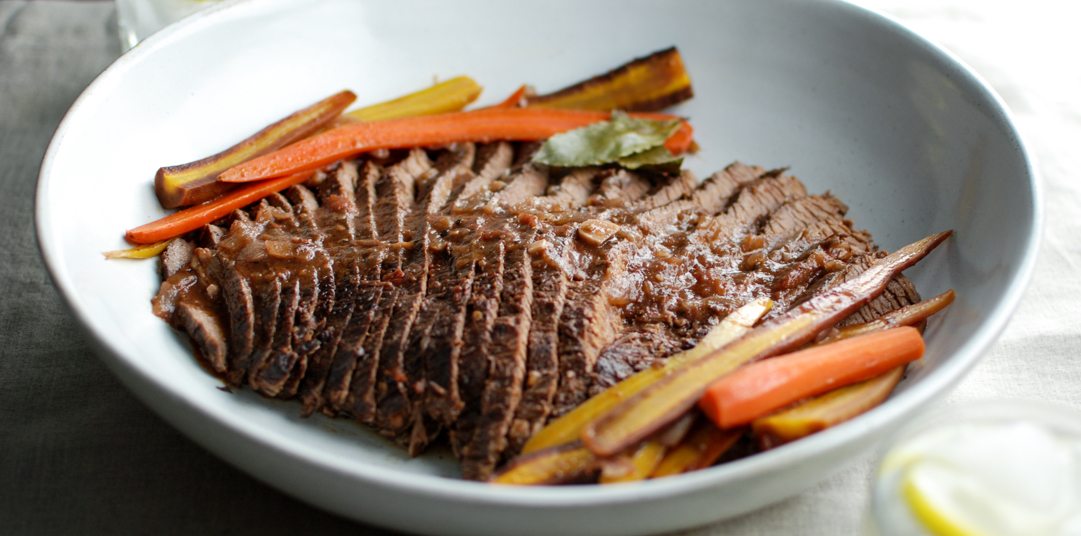
With braised beef, you’re looking for an even more tender end product, along with a delicious, aromatic sauce served with the meat.
This style usually uses a lot more ingredients, such as vegetables, aromatic herbs, oils, and spices. Some recipes call for things like soda, barbecue sauce, or “liquid smoke,” but for your first time, you may want to stick to the traditional stuff: carrots, onions, bay leaves, lemon, and garlic.
You’ll also need a cast iron pot or dutch oven. If you’re planning to use a slow cooker, you may just need an additional skillet to sear the outside of the meat before placing it in the cooker.
Pro tip: Cooking it ahead of time can make the process simpler and with less mess on the day of your special occasion. Plus, the braised beef brisket is even more flavorful after resting overnight!
Once you have all of your things organized, here’s how to braise your brisket:
- Preheat oven to 350 degrees F.
- Pat the brisket dry and season with salt and pepper.
- Add cooking oil to your pot and heat at medium high on your stove top.
- Once the oil shimmers, sear the brisket on all sides and then place the meat on a plate. Sear each side until it releases easily, usually 3-6 minutes per side.
- If applicable, add onions and garlic to pan, cook to soften, and then deglaze pan with red wine or stock. Scrape up the dark and flavorful bits at the bottom of the pan (known as “fond”) and remove pot from heat.
- Add your brisket to your pot, surround with other vegetables (carrots, celery, more garlic) replace the lid, and then place it in your warmed oven.
- Check on it and pour the simmering juices over the brisket every 30 minutes, but be sure you place the lid TIGHT every time.
- After 2-2.5 hours, probe your brisket with a fork. For slices of brisket, you want it to give, but not shred. For melt-in your mouth brisket, after 3 to 3.5 hours, it should be falling apart easily. You’re done!
To eat immediately, just let the brisket cool enough to handle, and slice against the grain.
To serve up to 3 days later, store it in the fridge submerged with the cooking liquid. To reheat, slice while cold then nestle slices in the cooking liquid/sauce. Pour any extra liquid on top. Cover tightly. Reheat at 250 degrees F for 45 minutes.
Depending on the ingredients, the juices may turn into a stew to serve along with the meat, or simply a delicious broth to freeze and use in other recipes. Anna’s grandmother puts the juices and vegetables in the blender to make a thick, pureed sauce which is incredible. If you like, skim off any excess fat that floats to the top of the broth before reheating.
Here are some more of our favorite braised brisket recipes:
- Red Wine & Honey Brisket – Leah Koenig
- Caramelized Onions Brisket – Jamie Geller
- Simple Brisket – Rachel Rosen
Congrats — You’re Ready To Cook Beef Brisket!
Are you ready to cook the best beef brisket of your life? If you’re a little scared, that’s okay. Anything
that’s worth doing in life takes some work.
Remember though, it all starts with the right ingredients. Don’t skimp on your brisket — starting with good meat makes your job a lot easier and you’ll get a lot more compliments because it’s already naturally tastier. Don’t worry, you can have all the credit — our treat. ????
